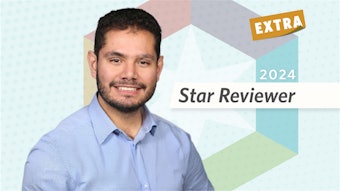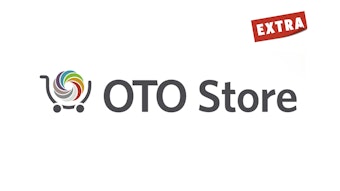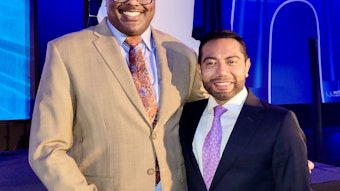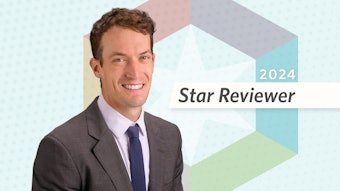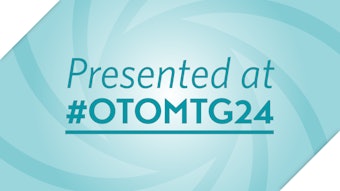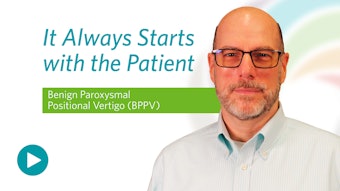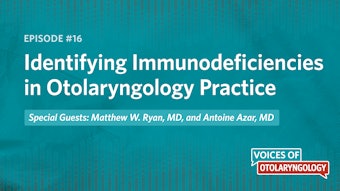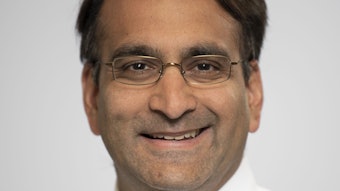No One Left Unheard
With large gaps in the global landscape of ear and hearing care access and education, robust educational tools are essential for combating hearing loss in underresourced settings.
David Fei-Zhang, MD, MBA, Stefany Lazieh, BA, Asitha Jayawardena, MD, MPH, Lillian Mokoh, MBChB, MMed, Gratien Tuyishimire, MBBS, MMed, Carolina Der, MD, PhD, James Saunders, MD, MS, on behalf of the Global Otolaryngology-Head and Neck Surgery Initiative

Despite the pressing need for evidence-based intervention, many LMICs face challenges in delivering effective ear and hearing care (EHC). One major obstacle is the severe shortage of specialized providers such as audiologists and otolaryngologists-head and neck surgeons. For instance, Kenya has only one otolaryngologist-head and neck surgeon per 454,546 people and one audiologist per 3,333,333 people, while Rwanda has shown similarly low figures.3 These numbers fall short of the World Health Organization’s (WHO) recommendation of four specialists per 100,000 individuals.4
Beyond these obstacles, other systemic barriers include:
Infrastructure Constraints: People living in underserved, rural regions often face challenges of distance, transportation, and inadequate equipment.5
Geographic Distribution: Most specialists and advanced facilities are concentrated in urban centers rather than in rural areas.5
Cultural and Stigma-Related Barriers: Persistent misperception about hearing loss can deter individuals from seeking care.5
Lack of Government Recognition: EHC is severely underrepresented within national health policies of LMICs.6
Humanitarian Response: Despite hearing loss’s comparable level of burden to other prominent diseases and pathologies, global aid has primarily focused investments into non-EHC conditions.7,8
These gaps underscore the urgent need for a more widespread, practical model of care that can serve the millions affected by hearing loss in resource-restrained settings.
Addressing Barriers through Integrating EHC in Primary Health
To overcome these challenges, efforts from global bodies to expand EHC services have looked towards decentralizing specialist care into primary health systems.4 Primary care networks, which are often more established than those for specialists in LMICs, have proved to be an ideal platform for delivering essential care in other specialty-related services. For instance, systematic improvements to the Rwandan primary and community health system brought a 75% reduction in maternal mortality.9 In addition, community health worker networks in Kenya have effectively used mobile health technologies to enhance patient monitoring and specialist care arrangement.10
When applied to EHC, these decentralization strategies could involve the following:
Training Primary Healthcare Workers: By incorporating basic hearing screenings and diagnostic services at the primary care level, preventive and early-stage interventions can be enacted for a wider range of patients.
Leveraging Technology: Tele-audiology and mobile health screening tools can support remote diagnostic and specialist consultations in low-resource areas.
Community Engagement and Grassroots Awareness Campaigns: Addressing sociocultural stigma and promoting awareness of hearing health can improve acceptance of interventions.
Policy Integration: Prioritization of EHC should be increased within national health strategies to promote systematic understanding of and sustainable solutions to the burdens of ear and hearing conditions.
Available Tools for EHC Education
Among the strategies to tackle these care gaps, the adaptation of robust educational tools has become a cornerstone in sustaining decentralization efforts in under-resourced settings. Of these tools, the WHO’s updated Primary Ear and Hearing Care Training Manual serves as a valuable resource to enhance training and capacity-building in EHC.11 Developed by a global coalition of EHC experts and updated in 2023, this educational tool offers a comprehensive, multi-applicable curriculum featuring the following:
Modular Structure: As a four-day course comprising 10 modules, the curriculum covers the basic anatomy and physiology of the ear, common ear conditions and their management, hearing assessment techniques, rehabilitation and referral pathways, and potential community-based preventive strategies.
Contextual Adaptability: The training material is designed to be modified according to local language, cultural practices, and available resources.
Facilitator Support: A dedicated training manual provides guidelines for educators, ensuring a universal standard for effective delivery and evaluation of the curriculum.
Initial implementation of this educational tool has shown promise in countries such as Fiji, Zambia, and Malawi.12,13 However, the evidence remains limited to short-term outcomes, underscoring the need for comprehensive, long-term evaluations to understand its individual and system-wide impact.
Collaborative Approaches Toward Providing EHC
Tackling these complex challenges of EHC provision and educational evaluation requires concerted efforts in investigations and partnerships. Multifaceted stakeholders across varied disciplines—including policymakers, global health researchers, implementation scientists, technology entrepreneurs, primary care providers, EHC specialists, and others—must come together to advance these efforts. Furthermore, multinational partnerships from local and international stakeholders will be imperative for developing adaptive approaches tailored to the specific needs of each geographical context.
Among these initiatives, local and global organizations have developed coalitions to tackle these multilevel, systems-based challenges within the EHC sphere. These groups comprise investigators and specialists from numerous high-income and low-middle-income institutions, stakeholders from local ministries of health, international advisers, members of the private sector, and nonprofits, such as the Global OHNS Initiative, among others.14 Current efforts from this partnership involve the following:
Contextual Curriculum Adaptation: Collaborators are working to modify training materials to align with local languages, cultural contexts, and specific ancillary resource availability.
Preliminary Surveys of Local Care and Education: The knowledge, attitudes, and perceptions of primary healthcare workers in LMIC settings across multiple countries are being surveyed.
Pilot Study Planning: Early-stage pilot programs are being developed to assess the feasibility and effectiveness of implementing the WHO’s training manual for primary healthcare workers in LMIC settings.
Accompaniment of Local and Global Partners: Local institutions and ministries of health are working with international partners to develop standardized investigative protocols that incorporate the means of adapting efforts towards local contexts.
Research Training and Funding Opportunities: Interdisciplinary effort across prospective data collection, survey-based work, community engagement, health policy, educational evaluation, and implementation sciences has fueled local and global knowledge exchange. The development of these skills among local and global teams has facilitated greater opportunities for research funding.
Conclusion
As the prevalence of hearing loss continues to rise, strategically providing EHC will require greater emphasis on addressing barriers across multiple levels. The gains seen with novel interventions and technological innovations must coincide with coordinated efforts to expand the trained EHC workforce, integrate within sociopolitical infrastructures, and support longitudinal evaluations of effective delivery mechanisms. Collaboration across geographies, disciplines, and industries will be instrumental in raising EHC’s prioritization within national health policies and garnering heightened interest among potential funders. Ultimately, achieving equitable EHC access across multinational health systems will require sustainable initiatives and a unified vision across its many stakeholders—to leave no one unheard.
The Global Otolaryngology-Head and Neck Surgery Initiative is a 501(c)(3) nonprofit corporation that seeks to advance the availability, accessibility, and quality of global otolaryngology-head and neck surgery subspecialty care through research, advocacy, and co-development. To learn more, visit the organization’s website https://www.globalohns.org/.
Note: The Global Otolaryngology-Head and Neck Surgery Initiative is not directly affiliated with the American Academy of Otolaryngology–Head and Neck Surgery or its Foundation. The views expressed in this content are solely those of the authors and may or may not be shared by the AAO-HNS/F.
References
- Haile LM, Kamenov K, Briant PS, et al. Hearing loss prevalence and years lived with disability, 1990–2019: findings from the Global Burden of Disease Study 2019. The Lancet. 2021;397(10278):996-1009. doi:10.1016/S0140-6736(21)00516-X
- McDaid D, Park AL, Chadha S. Estimating the global costs of hearing loss. International Journal of Audiology. 2021;60(3):162-170. doi:10.1080/14992027.2021.1883197
- Petrucci B, Okerosi S, Patterson RH, et al. The Global Otolaryngology–Head and Neck Surgery Workforce. JAMA Otolaryngol Head Neck Surg. 2023;149(10):904-911. doi:10.1001/jamaoto.2023.2339
- Organization WH. World Report on Hearing. World Health Organization; 2021. Accessed February 10, 2025. https://iris.who.int/handle/10665/339913
- Waterworth CJ, Marella M, O’Donovan J, Bright T, Dowell R, Bhutta MF. Barriers to access to ear and hearing care services in low- and middle- income countries: A scoping review. Global Public Health. 2022;17(12):3869-3893. doi:10.1080/17441692.2022.2053734
- Canick J, Petrucci B, Patterson R, et al. An analysis of the inclusion of ear and hearing care in national health policies, strategies and plans. Health Policy and Planning. 2023;38(6):719-725. doi:10.1093/heapol/czad026
- Gutnik L, Dieleman J, Dare AJ, et al. Funding allocation to surgery in low and middle-income countries: a retrospective analysis of contributions from the USA. BMJ Open. 2015;5(11):e008780. doi:10.1136/bmjopen-2015-008780
- Dieleman JL, Schneider MT, Haakenstad A, et al. Development assistance for health: past trends, associations, and the future of international financial flows for health. The Lancet. 2016;387(10037):2536-2544. doi:10.1016/S0140-6736(16)30168-4
- Binagwaho A, Farmer PE, Nsanzimana S, et al. Rwanda 20 years on: investing in life. Lancet. 2014;384(9940):371-375. doi:10.1016/S0140-6736(14)60574-2
- MoH | Ministry of Health. Accessed February 10, 2025. https://www.health.go.ke/
- Primary ear and hearing care training manual. Accessed February 10, 2025. https://www.who.int/teams/noncommunicable-diseases/sensory-functions-disability-and-rehabilitation/primary-ear-and-hearing-care-training-manual
- Bhutta MF, Bu X, de Muñoz PC, Garg S, Kong K. Training for hearing care providers. Bull World Health Organ. 2019;97(10):691-698. doi:10.2471/BLT.18.224659
- Mulwafu W, Ensink R, Kuper H, Fagan J. Survey of ENT services in sub-Saharan Africa: little progress between 2009 and 2015. Glob Health Action. 2017;10(1):1289736. doi:10.1080/16549716.2017.1289736
- The Global OHNS Initiative | Otolaryngology - Head Neck Surgery. Global OHNS. Accessed February 10, 2025. https://www.globalohns.org


